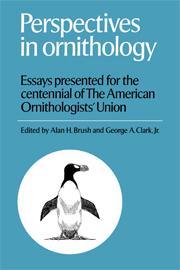 Perspectives in Ornithology
Perspectives in Ornithology Book contents
- Frontmatter
- Contents
- List of contributors
- Preface
- Introduction
- 1 Captive birds and conservation
- 2 Research collections in ornithology – a reaffirmation
- 3 On the study of avian mating systems
- 4 Cooperative breeding strategies among birds
- 5 Ecological energetics: what are the questions?
- 6 Perspectives in optimal foraging
- 7 Biochemical studies of microevolutionary processes
- 8 Organization of the avian genome
- 9 The origin and early radiation of birds
- 10 Avian community ecology: an iconoclastic view
- 11 Biogeography: the unification and maturation of a science
- 12 Bird song learning: theme and variations
- 13 Bird navigation
- Index
12 - Bird song learning: theme and variations
Published online by Cambridge University Press: 04 August 2010
- Frontmatter
- Contents
- List of contributors
- Preface
- Introduction
- 1 Captive birds and conservation
- 2 Research collections in ornithology – a reaffirmation
- 3 On the study of avian mating systems
- 4 Cooperative breeding strategies among birds
- 5 Ecological energetics: what are the questions?
- 6 Perspectives in optimal foraging
- 7 Biochemical studies of microevolutionary processes
- 8 Organization of the avian genome
- 9 The origin and early radiation of birds
- 10 Avian community ecology: an iconoclastic view
- 11 Biogeography: the unification and maturation of a science
- 12 Bird song learning: theme and variations
- 13 Bird navigation
- Index
Summary
Perhaps the greatest attraction of bird song to scientist and layman alike is its immense variety. In some birds, songs are brief and discrete, whereas in others they can continue for long periods without a break. In some, each male has but a single phrase that is repeated in identical form; in others, the repertoire of phrases is so large that it is difficult to measure exactly. In some species, neighbors tend to have similar songs; in others, they do not. There are species in which the female sings as well as the male, there are those that sing at times of year far removed from breeding, there are those that sing loudly from conspicuous perches and those that sing quietly from the deepest undergrowth. With all this variety, generalizations about bird song are not easy to come by, even if one considers only the songbirds (Oscines), and the knowledgeable will think of exceptions to every rule.
One likely reason for this variation is that the function of song differs among species. Three main functions for song have been suggested: that it repels rivals, that it attracts mates, and that it stimulates the female to lay eggs. There is some experimental evidence for each of these (e.g., Kroodsma 1976; Wasserman 1977; Falls 1978).
- Type
- Chapter
- Information
- Perspectives in OrnithologyEssays Presented for the Centennial of the American Ornitholgists' Union, pp. 475 - 512Publisher: Cambridge University PressPrint publication year: 1983
- 26
- Cited by


